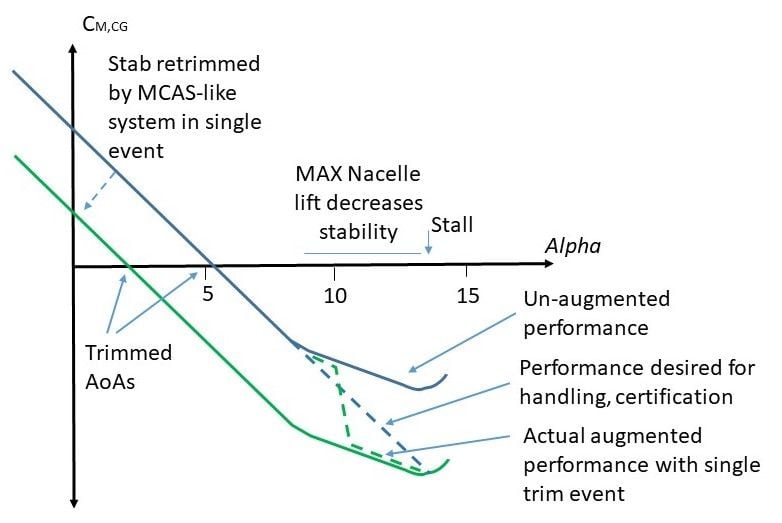Originally Posted by
LEOCh
What information is available points to a MCAS software update that increases the robustness of the AoA input but restricts stab trim output to one cycle only.
However, I don't understand how a single trim cycle could really create a particularly effective augmented stability. The trouble is, we really don't know much about the characteristics of MAX stability, and only part of the MCAS algorithm parameters. But it is likely that the Cm versus alpha curves for the unaugmented MAX tend to show a pre-stall region of decreased stability (not instability) due to Nacelle lift as below. This makes it easier to pull through the pre-stall region than at lower AoAs, and breaks certification.
A control loop more robust and sophisticated than MCAS that senses AoA and actuates stab trim to make the desired Cm vs. alpha plot might be possible (although not necessarily a good idea). However, an MCAS2 that outputs only one trim event should produce something more like the plot below. Apologies for the large amount of assumptions and simplifications for this plot, but for want of more accurate values, the nacelle lift region stretches from AoA 8' to 14' (where the wing stalls). The MCAS-like system is putting in a single trim event (triggered at 10' AoA) that is effectively trimming the aircraft from AoA 5' to 2' (if the column was returned to neutral).
The single trim event augmented performance is a very ragged approximation of the desired behaviour, in fact if you resisted the trim message from this MCAS2 by pulling through it, you would be back in the lower stability regime again until stall. If the lower stability region breaks certification it seems rather an ineffective fix.

LEOCh,
Very good questions and excellent example diagram. Most of the focus in this and other threads related to how MCAS behaves with an AOA sensor that is failed to a very high value (or with a large positive bias) describes MCAS activating for its full increment in one shot. MCAS actually schedules its airplane nose down stabilizer motion over a range of AOA starting at the activation value and extending as AOA goes higher. If you transition through this AOA range quickly (faster than the stab can run to keep up with the schedule) the whole MCAS increment goes in as one continuous trim event. If AOA increases slowly, however, MCAS will put in a little stabilizer at a time to keep up with the MCAS stab vs. AOA schedule. The MCAS trim will go in at the same 0.27 deg/sec rate but the trim will start and stop as needed depending on AOA time history.
FCeng84